重庆医科大学:《诊断学》课程教学资源(授课教案)03 呕血
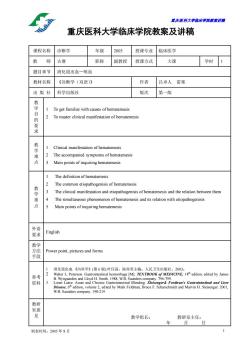
置庆医科大半脑床半院藏未讲满 重庆医科大学临床学院教案及讲稿 课程名称诊断学 年级2005授课专业临床医学 教师古赛 职称副教投授课方式 大课 学时1 题目章节消化道出血一呕血 教材名称《诊断学(双语)》 作者吕卓人雷寒 出版社科学出版社 版次第一版 教 To get familiar with causes of hematemasis 学目的要求 2 To master clinical manifestation of hematemesis 1 Clinical manifestation of hematemesis The accompanied symptoms ofhematemesis Main points of inquiring hematemesis The definition of hematemesis The common etiopathogenisis of hematemesis The clinca manifestation and etiopathogenisis of hematemesis and the reation between them 重点 The simultaneous phenomenon of hematemesis and its relation with etiopathogenisis Main points of inquiring hematemesis 外语 要求 English Power point,pictures and forms 手段 参考 资料 教研 教学组长 年 教研室主任 日 制表时间:2005年8月
重庆医科大学临床学院教案讲稿 制表时间:2005 年 8 月 1 重庆医科大学临床学院教案及讲稿 课程名称 诊断学 年级 2005 授课专业 临床医学 教 师 古赛 职称 副教授 授课方式 大课 学时 1 题目章节 消化道出血—呕血 教材名称 《诊断学(双语)》 作者 吕卓人 雷寒 出 版 社 科学出版社 版次 第一版 教 学 目 的 要 求 1 To get familiar with causes of hematemasis 2 To master clinical manifestation of hematemesis 教 学 难 点 1 Clinical manifestation of hematemesis 2 The accompanied symptoms of hematemesis 3 Main points of inquiring hematemesis 教 学 重 点 1 The definition of hematemesis 2 The common etiopathogenisis of hematemesis 3 The clinical manifestation and etiopathogenisis of hematemesis and the relation between them 4 The simultaneous phenomenon of hematemesis and its relation with etiopathogenisis 5 Main points of inquiring hematemesis 1. mesis 外语 要求 English 教学 方法 手段 Power point, pictures and forms 参考 资料 1 消化道出血.《内科学》(第 6 版).叶任高,陆再英主编。人民卫生出版社,2003。 2 Walter L. Peterson. Gastrointestinal hemorrhage [M]. TEXTBOOK of MEDICINE, 18th edition, edited by James B. Wyngaarden and Lloyd H. Smith. 1988, W.B. Saunders company. 796-799. 3 Loren Laine. Acute and Chronic Gastrointestinal Bleeding. Sleisenger& Fordtran’s Gastrointestinal and Liver Disease, 6th edition, volume 2, edited by Mark Feldman, Bruce F. Scharschmidt and Marvin H. Sleisenger. 2001, W.B. Saunders company. 198-219 教研 室意 见 教学组长: 教研室主任: 年 月 日
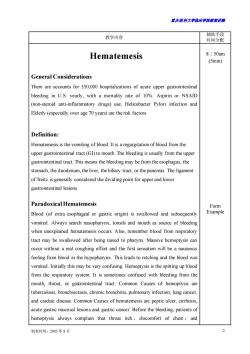
露庆医科大学临床半蕊载案讲满 教学内容 Hematemesis 8:50am (5min) General Considerations There are accounts for 350,000 hospitalizations of acute upper gastrointestinal bleeding in U.S.yearly,with a mortality rate of 10%.Aspirin or NSAID (non-steroid anti-inflammatory drugs)use,Helicobacter Pylori infection and Elderly (especially over age 70 years)are the risk factors. Definition: Hematemesis is the vomiting of blood.It is a regurgitation of blood from the upper gastrointestinal tract(GI)to mouth.The bleeding is usually from the upper gastrointestinal tract.This means the bleeding may be from the esophagus,the stomach,the duodenum,the liver,the biliary tract,or the pancreas.The ligament of Treitz is generally considered the dividing point for upper and lower gastrointestinal lesions. Paradoxical Hematemesis Blood (of extra esophageal or gastric origin)is swallowed and subsequently me vomited.Always search nasopharynx,tonsils and mouth as source of bleeding when unexplained hematemesis occurs.Also,remember blood from respiratory tract may be swallowed after being raised to pharynx.Massive hemoptysis can occur without a real coughing effort and the first sensation will be a nauseous feeling from blood in the hypopharynx.This leads to retching and the blood was vomited.Initially this may be very confusing Hemoptysis is the spitting up bloo from the respiratory system.It is sometimes confused with bleeding from the mouth,throat,or gastrointestinal tract.Common Causes of hemoptysis ar tuberculosis,bronchiectasis,chronic bronchitis,pulmonary infection,lung cancer and cardiac disease.Common Causes of hematemesis are peptic ulcer,cirrhosis acute gastric mucosal lesions and gastric cancer.Before the bleeding,patients of hemoptysis always complain that throat itch,discomfort of chest,and 制表时间:2005年8月
重庆医科大学临床学院教案讲稿 制表时间:2005 年 8 月 2 教学内容 辅助手段 时间分配 Hematemesis General Considerations There are accounts for 350,000 hospitalizations of acute upper gastrointestinal bleeding in U.S. yearly, with a mortality rate of 10%. Aspirin or NSAID (non-steroid anti-inflammatory drugs) use, Helicobacter Pylori infection and Elderly (especially over age 70 years) are the risk factors. Definition: Hematemesis is the vomiting of blood. It is a regurgitation of blood from the upper gastrointestinal tract (GI) to mouth. The bleeding is usually from the upper gastrointestinal tract. This means the bleeding may be from the esophagus, the stomach, the duodenum, the liver, the biliary tract, or the pancreas. The ligament of Treitz is generally considered the dividing point for upper and lower gastrointestinal lesions. Paradoxical Hematemesis Blood (of extra esophageal or gastric origin) is swallowed and subsequently vomited. Always search nasopharynx, tonsils and mouth as source of bleeding when unexplained hematemesis occurs. Also, remember blood from respiratory tract may be swallowed after being raised to pharynx. Massive hemoptysis can occur without a real coughing effort and the first sensation will be a nauseous feeling from blood in the hypopharynx. This leads to retching and the blood was vomited. Initially this may be very confusing. Hemoptysis is the spitting up blood from the respiratory system. It is sometimes confused with bleeding from the mouth, throat, or gastrointestinal tract. Common Causes of hemoptysis are tuberculosis, bronchiectasis, chronic bronchitis, pulmonary infection, lung cancer, and cardiac disease. Common Causes of hematemesis are peptic ulcer, cirrhosis, acute gastric mucosal lesions and gastric cancer. Before the bleeding, patients of hemoptysis always complain that throat itch , discomfort of chest , and 8:50am (5min) Form Example
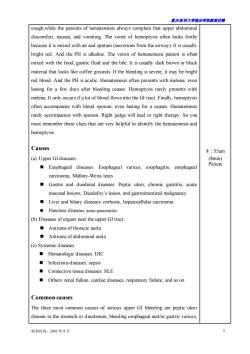
置庆医科大半脑床半鹿藏未讲满 cough,while the patients of hematemesis always complain that upper abdominal discomfort,nausea,and vomiting.The vomit of hemoptysis often looks frothy because it is mixed with air and sputum(secretions from the airway).It is usually bright red.And the PH is alkaline.The vomit of hematemesis patient is often mixed with the food,gastric fluid and the bile.It is usually dark brown or black material that looks like coffee grounds.If the bleeding is severe,it may be bright ed blood.And the PH is acidic.Hematemesis often presents with melena,ever asting for a few days after bleeding ceases.Hemoptysis rarely presents with melena.It only occurs if a lot of blood flows into the GI tract.Finally,hemoptysis often accompanies with blood sputum,even lasting for a ceases.Hematemesis rarely accompanies with sputum.Right judge will lead to right therapy.So you must remember these clues that are very helpful to identify the hematemesis and hemoptysis. Causes 8:55am (a)Upper GI diseases: Esophageal diseases:Esophageal varices,esophagitis,esophagea carcinoma,Mallory-Weiss tears Gastric and duodenal diseases:Peptic ulcer,chronic gastritis,acut mucosal lesions,Dieulafoy's lesion,and gastrointestinal malignancy Liver and biliary diseases:cirrhosis,hepatocellular carcinoma Pancreas diseases:acute pancreatitis (b)Diseases of organs near the upper GI tract: Antrums of thoracic aorta Antrums of abdominal aorta (c)Systemicdiseases Hematologic diseases:DIC Connective tissue diseases:SLE Others:renal failure,cardiac diseases,respiratory failure,and so on Common causes The three most common causes of serious upper GI bleeding are peptic ulce disease in the stomach or duodenum,bleeding esophageal and/or gastric varices 制表时间:2005年8月
重庆医科大学临床学院教案讲稿 制表时间:2005 年 8 月 3 cough,while the patients of hematemesis always complain that upper abdominal discomfort, nausea, and vomiting. The vomit of hemoptysis often looks frothy because it is mixed with air and sputum (secretions from the airway). It is usually bright red. And the PH is alkaline. The vomit of hematemesis patient is often mixed with the food, gastric fluid and the bile. It is usually dark brown or black material that looks like coffee grounds. If the bleeding is severe, it may be bright red blood. And the PH is acidic. Hematemesis often presents with melena, even lasting for a few days after bleeding ceases. Hemoptysis rarely presents with melena. It only occurs if a lot of blood flows into the GI tract. Finally, hemoptysis often accompanies with blood sputum, even lasting for a ceases. Hematemesis rarely accompanies with sputum. Right judge will lead to right therapy. So you must remember these clues that are very helpful to identify the hematemesis and hemoptysis. Causes (a) Upper GI diseases: ◼ Esophageal diseases: Esophageal varices, esophagitis, esophageal carcinoma, Mallory-Weiss tears ◼ Gastric and duodenal diseases: Peptic ulcer, chronic gastritis, acute mucosal lesions, Dieulafoy’s lesion, and gastrointestinal malignancy ◼ Liver and biliary diseases: cirrhosis, hepatocellular carcinoma ◼ Pancreas diseases: acute pancreatitis (b) Diseases of organs near the upper GI tract: ◼ Antrums of thoracic aorta ◼ Antrums of abdominal aorta (c) Systemic diseases ◼ Hematologic diseases: DIC ◼ Infectious diseases: sepsis ◼ Connective tissue diseases: SLE ◼ Others: renal failure, cardiac diseases, respiratory failure, and so on Common causes The three most common causes of serious upper GI bleeding are peptic ulcer disease in the stomach or duodenum, bleeding esophageal and/or gastric varices, 8:55am (8min) Picture
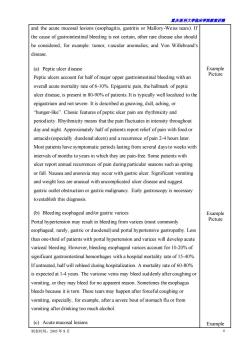
重庆医科大学临床半院载来讲满 and the acute mucosal lesions (esophagitis,gastritis or Mallory-Weiss tears).If the cause of gastrointestinal bleeding is not certain,other rare disease also should be considered,for example:tumor,vascular anomalies,and Von Willebrand's disease. (a)Peptic ulcer disease Example Peptic ulcers account for half of major upper gastrointestinal bleeding with an Picture overall acute mortality rate of6-10%.Epigastric pain,the hallmark of peptic ulcer disease,is present in 8-90%of patients.It is typically well localized to th epigastrium and not severe.It is described as gnawing.dull,aching.or "hunger-like"Classic features of peptic ulcer pain are rhythmicity and periodicity.Rhythmicity means that the pain fluctuates in intensity throughout day and night.Approximately half of patients report relief of pain with food or antacids(especially duodenal ulcers)and a recurrence of pain 2-4 hours later. Most patients have symptomatic periods lasting from several days to weeks with intervals of months to years in which they are pain-free.Some patients with ulcer report annual recurrences of pain during particular seasons such as spring or fall.Nausea and anorexia may occur with gastric ulcer.Significant vomiting and weight loss are unusual with uncomplicated ulcer disease and suggest gastric outlet obstruction or gastric malignancy.Early gastroscopy is necessary toestablish this diagnosis. (b)Bleeding esophageal and/or gastric varices Example Portal hypertension may result in bleeding from varices(most commonly Picture esophageal;rarely,gastric or duodenal)and portal hypertensive gastropathy.Less han one-third of patients with portal hypertension and varices will develop acute ariceal bleeding.However,bleeding esophageal varices account for 10-20%of significant gastrointestinal hemorhages with a hospital mortality rate of15-0% Ifuntreated,halfwill rebleed during hospitalization.A mortality rate of60-80% is expected at 1-4 years.The varicose veins may bleed suddenly after coughingo vomiting.or they may bleed for no apparent reason.Sometimes the esophagus bleeds because it is tom.These tears may happen after forceful coughing or vomiting,especially,for example,after a severe bout of stomach flu or from vomiting after drinking too much alcohol. (c)Acute mucosal lesions Example 制表时间:2005年8月 4
重庆医科大学临床学院教案讲稿 制表时间:2005 年 8 月 4 and the acute mucosal lesions (esophagitis, gastritis or Mallory-Weiss tears). If the cause of gastrointestinal bleeding is not certain, other rare disease also should be considered, for example: tumor, vascular anomalies, and Von Willebrand's disease. (a) Peptic ulcer disease Peptic ulcers account for half of major upper gastrointestinal bleeding with an overall acute mortality rate of 6-10%. Epigastric pain, the hallmark of peptic ulcer disease, is present in 80-90% of patients. It is typically well localized to the epigastrium and not severe. It is described as gnawing, dull, aching, or “hunger-like”. Classic features of peptic ulcer pain are rhythmicity and periodicity. Rhythmicity means that the pain fluctuates in intensity throughout day and night. Approximately half of patients report relief of pain with food or antacids (especially duodenal ulcers) and a recurrence of pain 2-4 hours later. Most patients have symptomatic periods lasting from several days to weeks with intervals of months to years in which they are pain-free. Some patients with ulcer report annual recurrences of pain during particular seasons such as spring or fall. Nausea and anorexia may occur with gastric ulcer. Significant vomiting and weight loss are unusual with uncomplicated ulcer disease and suggest gastric outlet obstruction or gastric malignancy. Early gastroscopy is necessary to establish this diagnosis. (b) Bleeding esophageal and/or gastric varices Portal hypertension may result in bleeding from varices (most commonly esophageal; rarely, gastric or duodenal) and portal hypertensive gastropathy. Less than one-third of patients with portal hypertension and varices will develop acute variceal bleeding. However, bleeding esophageal varices account for 10-20% of significant gastrointestinal hemorrhages with a hospital mortality rate of 15-40%. If untreated, half will rebleed during hospitalization. A mortality rate of 60-80% is expected at 1-4 years. The varicose veins may bleed suddenly after coughing or vomiting, or they may bleed for no apparent reason. Sometimes the esophagus bleeds because it is torn. These tears may happen after forceful coughing or vomiting, especially, for example, after a severe bout of stomach flu or from vomiting after drinking too much alcohol. (c) Acute mucosal lesions Example Picture Example Picture Example
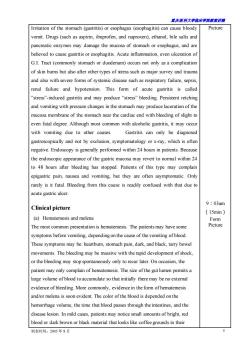
置庆医科大半脑床半鹿藏未讲满 Irritation of the stomach(gastritis)or esophagus (esophagitis)can cause bloody Picture vomit.Drugs(such as aspirin,ibuprofen,and naproxen),ethanol,bile salts and pancreatic enzymes may damage the mucosa of stomach or esophagus,and are believed to cause gastritis or esophagitis.Acute inflammation,even ulceration of G.I.Tract (commonly stomach or duodenum)occurs not only as a complication of skin burns but also after other types of stress such as major survey and trauma and also with severe forms of systemic disease such as respiratory failure,sepsis. renal failure and hypotension.This form of acute gastritis is called "stress"induced gastritis and may produce"stress"bleeding Persistent retching and vomiting with pressure changes in the stomach may produce laceration of the mucosa membrane of the stomach near the cardiac end with bleeding of slight to even fatal degree.Although most common with alcoholic gastritis,it may occur with vomiting due to other causes.Gastritis can only be diagnosed gastroscopically and not by exclusion,symptomatology or x-ray,which is often negative.Endoscopy is generally performed within 24 hours in patients.Because the endoscopic appearance of the gastric mucosa may revert to normal within 24 o 48 hours after bleeding has stopped.Patients of this type may complair epigastric pain,nausea and vomiting.but they are often asymptomatic.Only arely is it fatal.Bleeding from this cause is readily confused with that due to acute gastric ulcer. 9:03am Clinical picture (15min) (a)Hematemesis and melena Form The most common presentation is hematemesis.The patients may have some Picture symptoms before vomiting.depending on the cause of the vomiting of blood. These symptoms may be:heartbum,stomach pain,dark,and black,tarry bowel movements.The bleeding may be massive with the rapid development of shock. or the bleeding may stop spontaneously only to recur later.On occasion,the patient may only complain of hematemesis.The size of the gut lumen permits a large volume of blood to accumulate so that initially there may be no extemal evidence of bleeding.More commonly,evidence in the form of hematemesis nd/or melena is soon evident.The color of the blood is depended on the hemorhage volume,the time that blood passes through the intestines,and the disease lesion.In mild cases,patients may notice small amounts of bright,red blood or dark brown or black material that looks like coffee grounds in their 制表时间:2005年8月
重庆医科大学临床学院教案讲稿 制表时间:2005 年 8 月 5 Irritation of the stomach (gastritis) or esophagus (esophagitis) can cause bloody vomit. Drugs (such as aspirin, ibuprofen, and naproxen), ethanol, bile salts and pancreatic enzymes may damage the mucosa of stomach or esophagus, and are believed to cause gastritis or esophagitis. Acute inflammation, even ulceration of G.I. Tract (commonly stomach or duodenum) occurs not only as a complication of skin burns but also after other types of stress such as major survey and trauma and also with severe forms of systemic disease such as respiratory failure, sepsis, renal failure and hypotension. This form of acute gastritis is called “stress”-induced gastritis and may produce “stress” bleeding. Persistent retching and vomiting with pressure changes in the stomach may produce laceration of the mucosa membrane of the stomach near the cardiac end with bleeding of slight to even fatal degree. Although most common with alcoholic gastritis, it may occur with vomiting due to other causes. Gastritis can only be diagnosed gastroscopically and not by exclusion, symptomatology or x-ray, which is often negative. Endoscopy is generally performed within 24 hours in patients. Because the endoscopic appearance of the gastric mucosa may revert to normal within 24 to 48 hours after bleeding has stopped. Patients of this type may complain epigastric pain, nausea and vomiting, but they are often asymptomatic. Only rarely is it fatal. Bleeding from this cause is readily confused with that due to acute gastric ulcer. Clinical picture (a) Hematemesis and melena The most common presentation is hematemesis. The patients may have some symptoms before vomiting, depending on the cause of the vomiting of blood. These symptoms may be: heartburn, stomach pain, dark, and black, tarry bowel movements. The bleeding may be massive with the rapid development of shock, or the bleeding may stop spontaneously only to recur later. On occasion, the patient may only complain of hematemesis. The size of the gut lumen permits a large volume of blood to accumulate so that initially there may be no external evidence of bleeding. More commonly, evidence in the form of hematemesis and/or melena is soon evident. The color of the blood is depended on the hemorrhage volume, the time that blood passes through the intestines, and the disease lesion. In mild cases, patients may notice small amounts of bright, red blood or dark brown or black material that looks like coffee grounds in their Picture 9:03am (15min) Form Picture
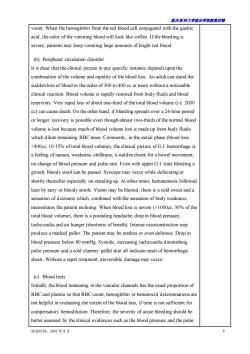
重庆医科大学脑床半院教来讲满 vomit.When the hemoglobin from the red blood cell conjugated with the gastric acid,the color of the vomiting blood will look like coffee.If the bleeding is severe,patients may keep vomiting large amounts of bright red blood. (b)Peripheral circulation disorder It is clear that the clinical picture in any specific instance dependsupon the combination of the volume and rapidity of the blood loss.An adult can stand the sudden loss of blood in the order of 300 to 400 cc or more without a noticeable clinical reaction.Blood volume is rapidly restored from body fluids and blood eservoirs.Very rapid loss ofabout one-third of the total blood volume(i.e.2000 cc)can cause death.On the other hand,if bleeding spreads over a24-hour period or longer,recovery is possible even though almost two-thirds of the normal blood volume is lost because much of blood volume lost is made up from body fluids which dilute remaining RBC mass.Commonly,in the initial phase(blood loss 400cc,10-15%of total blood volume),the clinical picture ofG.I.hemorrhage is a feeling of nausea,weakness,chilliness,a sudden desire for a bowel movement, o change of blood pressure and pulse rate.Even with upper G.I.tract bleeding a grossly bloody stool can be passed.Syncope may occur while defecatingor shortly thereafter especially on standing up.At other times,hematemesis followed later by tarry or bloody stools.Vision may be blurred:there is a cold sweat and a sensation of dizziness which,combined with the sensation of body weakness, necessitates the patient reclining.When blood loss is severe (>1000cc,30%of the total blood volume).there is a pounding headache,drop in blood pressure. tachycardia and air hunger(shortness of breath).Intense vasoconstriction may produce a marked pallor.The patient may be restless or even delirious.Drop in olood pressure below 80 mmHg.Systolic,increasing tachycardia diminishing pulse pressure and acold clammy pallid skin all indicate onset of hemorrhagic shock.Without a rapid treatment,irreversible damage may occur (c)Blood tests Initially the blood remaining in the vascular channels has the usual proportion of RBC and plasma so that RBC count,hemoglobin or hematocrit determinations are not helpful in evaluating the extent of the blood loss,if time is not sufficient for compensatory hemodilution.Therefore,the severity of acute bleeding should be betterassessed by the clinical evidences such as the blood pressure and the pulse 制表时间:2005年8月
重庆医科大学临床学院教案讲稿 制表时间:2005 年 8 月 6 vomit. When the hemoglobin from the red blood cell conjugated with the gastric acid, the color of the vomiting blood will look like coffee. If the bleeding is severe, patients may keep vomiting large amounts of bright red blood. (b) Peripheral circulation disorder It is clear that the clinical picture in any specific instance depends upon the combination of the volume and rapidity of the blood loss. An adult can stand the sudden loss of blood in the order of 300 to 400 cc or more without a noticeable clinical reaction. Blood volume is rapidly restored from body fluids and blood reservoirs. Very rapid loss of about one-third of the total blood volume (i.e. 2000 cc) can cause death. On the other hand, if bleeding spreads over a 24-hour period or longer, recovery is possible even though almost two-thirds of the normal blood volume is lost because much of blood volume lost is made up from body fluids which dilute remaining RBC mass. Commonly, in the initial phase (blood loss 1000cc, 30% of the total blood volume), there is a pounding headache, drop in blood pressure, tachycardia and air hunger (shortness of breath). Intense vasoconstriction may produce a marked pallor. The patient may be restless or even delirious. Drop in blood pressure below 80 mmHg. Systolic, increasing tachycardia diminishing pulse pressure and a cold clammy pallid skin all indicate onset of hemorrhagic shock. Without a rapid treatment, irreversible damage may occur. (c) Blood tests Initially the blood remaining in the vascular channels has the usual proportion of RBC and plasma so that RBC count, hemoglobin or hematocrit determinations are not helpful in evaluating the extent of the blood loss, if time is not sufficient for compensatory hemodilution. Therefore, the severity of acute bleeding should be better assessed by the clinical evidences such as the blood pressure and the pulse

重庆医科大半床半院载未讲满 rate. (d)Others Fever occurs in majority of patients with GI bleeding irrespective of the cause of bleeding.It usually appears within 24 hours,lasts days to a week or more,and may reach a maximum of38 centigrade.Fever after GI bleeding is related to endogenous breakdown of body protein.In such patients,elevated blood urea itrogen is also present. Accompanied symptoms One or more complications are commonly noted in patients with G.I.hemorrhage 9:18am that are related to this type of bleeding. (7min) Example (a)Syndrome of upper abdominal pain with Gastrointestinal Bleeding A younger patient,less than age 40.complained of a chronic upper abdominal pain.The features of this pain were hythmicity.periodicity and.So the first diagnosis may be peptic ulcer disease.Anelderly patient,over age 70 vears.suffered with a chronic upper abdominal pain,no rhythmicity and periodicity,and presented with dyspepsia,weight loss,anemia or evidence of occult gastrointestinal blood loss.Gastric cancer should be considered. (b)Syndrome of Hepatomegaly and splenomegaly Ifa patient has an enlarged spleen,spider nevi,palmar erythema,the superficial varicose veins of abdomen,ascites,and hepatic cell dysfunction,then the diagnosis of cirrhosis and portal hypertension should be considered.The most ommon presenting features of hepatocellular carcinoma are abdominal pain,the resence ofan abdominal mass,and weight loss.It may also present with rupture and hemoperitoneum,obstructive jaundice,unexplained deterioration in a patient with cirhosis,or a variety of paraneoplastic syndromes,including erthyrocytosis, persistent fever,hypercalcemia,and hypoglycemia.Increasing alpha-fetoprotein levels in serum are highly suggestive of hepatocellular carcinoma. (d)Jaundice Jaundice is due toelevated levels ofeither conjugated or unconjugated bilirubir in plasma and extracellular fluid.It is a common and important sign of disease 制表时间:2005年8月
重庆医科大学临床学院教案讲稿 制表时间:2005 年 8 月 7 rate. (d) Others Fever occurs in majority of patients with GI bleeding irrespective of the cause of bleeding. It usually appears within 24 hours, lasts days to a week or more, and may reach a maximum of 38 centigrade. Fever after GI bleeding is related to endogenous breakdown of body protein. In such patients, elevated blood urea nitrogen is also present. Accompanied symptoms One or more complications are commonly noted in patients with G.I. hemorrhage that are related to this type of bleeding. (a) Syndrome of upper abdominal pain with Gastrointestinal Bleeding A younger patient, less than age 40, complained of a chronic upper abdominal pain. The features of this pain were rhythmicity, periodicity and. recurrence. So the first diagnosis may be peptic ulcer disease. An elderly patient, over age 70 years, suffered with a chronic upper abdominal pain, no rhythmicity and periodicity, and presented with dyspepsia, weight loss, anemia or evidence of occult gastrointestinal blood loss. Gastric cancer should be considered. (b) Syndrome of Hepatomegaly and splenomegaly If a patient has an enlarged spleen, spider nevi, palmar erythema, the superficial varicose veins of abdomen, ascites, and hepatic cell dysfunction, then the diagnosis of cirrhosis and portal hypertension should be considered. The most common presenting features of hepatocellular carcinoma are abdominal pain, the presence of an abdominal mass, and weight loss. It may also present with rupture and hemoperitoneum, obstructive jaundice, unexplained deterioration in a patient with cirrhosis, or a variety of paraneoplastic syndromes, including erthyrocytosis, persistent fever, hypercalcemia, and hypoglycemia. Increasing alpha-fetoprotein levels in serum are highly suggestive of hepatocellular carcinoma. (d) Jaundice Jaundice is due to elevated levels of either conjugated or unconjugated bilirubin in plasma and extracellular fluid. It is a common and important sign of disease 9:18am (7min) Example
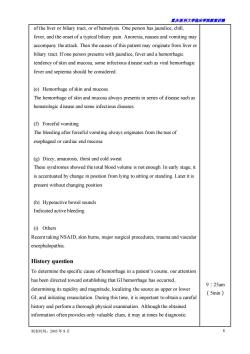
重庆医科大学临床半院藏案讲满 ofthe liver or biliary tract,or of hemolysis.One person has jaundice,chill, fever,and the onset of a typical biliary pain.Anorexia,nausea and vomiting may accompany the attack.Then the causes of this patient may originate from liver or biliary tract.Ifone person presents with jaundice,fever and a hemorrhagic tendency of skin and mucosa,some infectious disease such as viral hemorrhagic fever and septemia should be considered. (e)Hemorrhage of skin and mucosa The hemorrhage of skin and mucosa always presents in series of disease such as hematologic disease and some infectious diseases. (价Forceful vomiting The bleeding after forceful vomiting always originates from the tear of esophageal or cardiac end mucosa. (g)Dizzy,amaurosis,thirst and cold sweat These syndromes showed the total blood volume is not enough.In early stage,it is accentuated by change in position from lying to sitting or standing.Later it is present without changing position (h)Hyperactive bowel sounds Indicated active bleeding (i)Others Recent taking NSAID,skin burns,major surgical procedures,trauma and vascular encephalopathia. History question To determine the specific cause ofhemorrhage in a patient's course,our attention has been directed toward establishing that GI hemorrhage has occurred, 9:25am determining its rapidity and magnitude,localizing the source as upper or lower (5min)》 GI,and initiating resuscitation.During this time,it is important to obtain a careful history and perform a thorough physical examination.Although the obtained information often provides only valuable clues,it may at times be diagnostic. 制表时间:2005年8月
重庆医科大学临床学院教案讲稿 制表时间:2005 年 8 月 8 of the liver or biliary tract, or of hemolysis. One person has jaundice, chill, fever, and the onset of a typical biliary pain. Anorexia, nausea and vomiting may accompany the attack. Then the causes of this patient may originate from liver or biliary tract. If one person presents with jaundice, fever and a hemorrhagic tendency of skin and mucosa, some infectious disease such as viral hemorrhagic fever and septemia should be considered. (e) Hemorrhage of skin and mucosa The hemorrhage of skin and mucosa always presents in series of disease such as hematologic disease and some infectious diseases. (f) Forceful vomiting The bleeding after forceful vomiting always originates from the tear of esophageal or cardiac end mucosa. (g) Dizzy, amaurosis, thirst and cold sweat These syndromes showed the total blood volume is not enough. In early stage, it is accentuated by change in position from lying to sitting or standing. Later it is present without changing position. (h) Hyperactive bowel sounds Indicated active bleeding (i) Others Recent taking NSAID, skin burns, major surgical procedures, trauma and vascular encephalopathia. History question To determine the specific cause of hemorrhage in a patient’s course, our attention has been directed toward establishing that GI hemorrhage has occurred, determining its rapidity and magnitude, localizing the source as upper or lower GI, and initiating resuscitation. During this time, it is important to obtain a careful history and perform a thorough physical examination. Although the obtained information often provides only valuable clues, it may at times be diagnostic. 9:25am (5min)
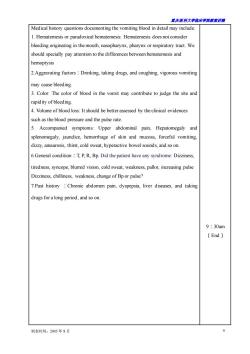
置庆医科大学脑床半未讲满 Medical history questions documenting the vomiting blood in detail may include: 1.Hematemesis or paradoxical hematemesis:Hematemesis does not consider bleeding originating in the mouth,nasopharynx,pharynx or respiratory tract.We should specially pay attention to the differences between hematemesis and hemoptysis 2.Aggravating factors:Drinking,taking drugs,and coughing,vigorous vomiting may cause bleeding. 3.Color:The color of blood in the vomit may contribute to judge the site and rapidity of bleeding. 4.Volume of blood loss:It should be better assessed by the clinical evidences such as the blood pressure and the pulse rate. 5.Accompanied symptoms:Upper abdominal pain,Hepatomegaly and splenomegaly,jaundice,hemorhage of skin and mucosa,forceful vomiting dizzy,amaurosis,thirst,cold sweat,hyperactive bowel sounds,and so on. 6.General condition:T,P.R.Bp.Did the patient have any syndrome:Dizziness, iredness,syncope,blurred vision,cold sweat,weakness,pallor,increasing pulse Dizziness,chilliness,weakness,change of Bpor pulse? 7.Past history Chronic abdomen pain,dyspepsia,liver diseases,and taking drugs for a long period,and so on. 9:30am (End) 制表时间:2005年8月
重庆医科大学临床学院教案讲稿 制表时间:2005 年 8 月 9 Medical history questions documenting the vomiting blood in detail may include: 1. Hematemesis or paradoxical hematemesis: Hematemesis does not consider bleeding originating in the mouth, nasopharynx, pharynx or respiratory tract. We should specially pay attention to the differences between hematemesis and hemoptysis 2.Aggravating factors:Drinking, taking drugs, and coughing, vigorous vomiting may cause bleeding. 3. Color: The color of blood in the vomit may contribute to judge the site and rapidity of bleeding. 4. Volume of blood loss: It should be better assessed by the clinical evidences such as the blood pressure and the pulse rate. 5. Accompanied symptoms: Upper abdominal pain, Hepatomegaly and splenomegaly, jaundice, hemorrhage of skin and mucosa, forceful vomiting, dizzy, amaurosis, thirst, cold sweat, hyperactive bowel sounds, and so on. 6.General condition:T, P, R, Bp. Did the patient have any syndrome: Dizziness, tiredness, syncope, blurred vision, cold sweat, weakness, pallor, increasing pulse Dizziness, chilliness, weakness, change of Bp or pulse? 7.Past history :Chronic abdomen pain, dyspepsia, liver diseases, and taking drugs for a long period, and so on. 9:30am (End)
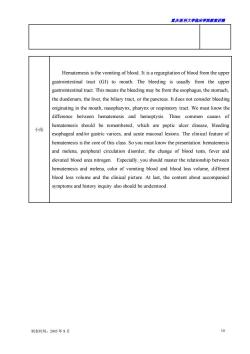
君庆医科大学脑床半院表来讲测 Hematemesis is the vomiting of blood.It is a regurgitation of blood from the upper gastrointestinal tract (GI)to mouth.The bleeding is usually from the upper gastrointestinal tract.This means the bleeding may be from the esophagus,the stomach, the duodenum,the liver,the biliary tract,or the pancreas.It does not consider bleeding originating in the mouth,nasopharynx,pharynx or respiratory tract.We must know the difference between hematemesis and hemoptysis.Three common causes of 小结 hematemesis should be remembered,which are peptic ulcer disease.bleeding esophageal and/or gastric varices,and acute mucosal lesions.The clinical feature of hematemesis is the core of this class.So you must know the presentation:hematemesis and melena,peripheral circulation disorder,the change of blood tests.fever and elevated blood urea nitrogen.Especially,you should master the relationship between hematemesis and melena,color of vomiting blood and blood loss volume,different blood loss volume and the clinical picture.At last,the content about accompanied symptoms and history inquiry also should be understood. 制表时间:2005年8月 10
重庆医科大学临床学院教案讲稿 制表时间:2005 年 8 月 10 小结 Hematemesis is the vomiting of blood. It is a regurgitation of blood from the upper gastrointestinal tract (GI) to mouth. The bleeding is usually from the upper gastrointestinal tract. This means the bleeding may be from the esophagus, the stomach, the duodenum, the liver, the biliary tract, or the pancreas. It does not consider bleeding originating in the mouth, nasopharynx, pharynx or respiratory tract. We must know the difference between hematemesis and hemoptysis. Three common causes of hematemesis should be remembered, which are peptic ulcer disease, bleeding esophageal and/or gastric varices, and acute mucosal lesions. The clinical feature of hematemesis is the core of this class. So you must know the presentation: hematemesis and melena, peripheral circulation disorder, the change of blood tests, fever and elevated blood urea nitrogen. Especially, you should master the relationship between hematemesis and melena, color of vomiting blood and blood loss volume, different blood loss volume and the clinical picture. At last, the content about accompanied symptoms and history inquiry also should be understood
按次数下载不扣除下载券;
注册用户24小时内重复下载只扣除一次;
顺序:VIP每日次数-->可用次数-->下载券;
- 重庆医科大学:《诊断学》课程教学资源(授课教案)04 便血.doc
- 重庆医科大学:《实验诊断学》课程教学资源(PPT课件)第八讲 脑脊液常规及生殖系统检查.ppt
- 重庆医科大学:《实验诊断学》课程教学资源(PPT课件)第七讲 大便常规、免疫学检查及心肌标志物检查.ppt
- 重庆医科大学:《实验诊断学》课程教学资源(PPT课件)第六讲 肾功能检查(主讲:唐敏).ppt
- 重庆医科大学:《实验诊断学》课程教学资源(PPT课件)第四讲 血栓与出血检查(主讲:胥文春).ppt
- 重庆医科大学:《实验诊断学》课程教学资源(PPT课件)第三讲 骨髓细胞学检查、血型与输血.ppt
- 重庆医科大学:《实验诊断学》课程教学资源(PPT课件)第一讲 总论及血液一般检查(上).ppt
- 上海科学技术出版社:《实验诊断学——彩色图谱》书籍PDF电子版(主编:张丽霞、陈金宝).pdf
- 重庆医科大学:《实验诊断学》课程复习题集(无答案).doc
- 《实验诊断学》课程实验指导书 laboatoty diagnosis(共九章,含练习及答案).doc
- 重庆医科大学:《实验诊断学》课程教学资源(教案)第8讲 CSF生殖系统.doc
- 重庆医科大学:《实验诊断学》课程教学资源(教案)第7讲 大便 免疫 心肌.doc
- 重庆医科大学:《实验诊断学》课程教学资源(教案)第6讲 肾功能.doc
- 重庆医科大学:《实验诊断学》课程教学资源(教案)第2讲 血液(下).doc
- 重庆医科大学:《实验诊断学》课程实验教学大纲(供临床医学专业本科用).doc
- 重庆医科大学:《实验诊断学》课程理论教学大纲(供五年制临床医学、儿科医学、预防医学、麻醉医学、影像医学专业本科使用).doc
- 石河子大学:《妇产科护理学》课程教学课件(PPT讲稿)第四章 妊娠期妇女的护理.ppt
- 石河子大学:《妇产科护理学》课程教学课件(PPT讲稿)第二章 女性生殖系统解剖与生理.ppt
- 石河子大学:《妇产科护理学》课程教学课件(PPT讲稿)第一章 绪论 Obstetric and Gynecological Nursing.ppt
- 石河子大学:《妇产科护理学》课程教学课件(PPT讲稿)第六章 产褥期管理.ppt
- 重庆医科大学:《诊断学》课程教学资源(授课教案)09 病历与诊断.doc
- 重庆医科大学:《诊断学》课程教学资源(授课教案)08 腹部检查.doc
- 重庆医科大学:《诊断学》课程教学资源(授课教案)01 绪论与问诊.doc
- 重庆医科大学:《诊断学》课程教学资源(授课教案)02 水肿.doc
- 重庆医科大学:《诊断学》课程教学资源(授课教案)07 黄疸.doc
- 重庆医科大学:《诊断学》课程教学资源(授课教案)05 腹痛.doc
- 重庆医科大学:《诊断学》课程教学资源(授课教案)06 腹泻.doc
- 重庆医科大学:《诊断学》课程教学资源(授课教案)14 心电图.doc
- 重庆医科大学:《诊断学》课程教学资源(授课教案)11 心脏检查.doc
- 重庆医科大学:《诊断学》课程教学资源(授课教案)20 呼吸系统症状和体征.doc
- 重庆医科大学:《诊断学》课程教学资源(授课教案)13 循环系统主要症状与体征.doc
- 重庆医科大学:《诊断学》课程教学资源(授课教案)15 超声心动图检查.doc
- 重庆医科大学:《诊断学》课程教学资源(授课教案)12 血管检查.doc
- 重庆医科大学:《诊断学》课程教学资源(授课教案)10 发热.doc
- 重庆医科大学:《诊断学》课程教学资源(授课教案)19 胸部检查.doc
- 重庆医科大学:《诊断学》课程教学资源(授课教案)18 呼吸困难.doc
- 重庆医科大学:《诊断学》课程教学资源(授课教案)16 咳嗽、咳痰.doc
- 重庆医科大学:《诊断学》课程教学资源(授课教案)17 咯血.doc
- 医学临床本科《MRI诊断学》课程教学大纲 Magnetic Resonance Imaging Diagnosis.doc
- 医学临床本科《影像诊断学》课程教学大纲 medical imaging(包含MRI部分).doc
